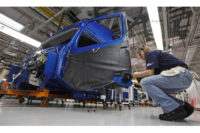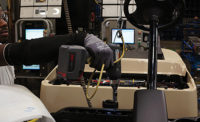TUVE, Sweden—Every time an assembler uses an electric fastening tool at the Volvo Group truck factory here, the data from the operation is logged and stored. Engineers are now using that data to increase quality.
A truck has thousands of bolted joints. Most of the time, assemblers use pneumatic fastening tools to tighten them to a predefined torque. But, for the most critical bolted joints, assemblers use electric tools.
“It is the clamping force that decides if the bolted joint is tightened enough,” says Filip Bergman, bolted joint specialist at Volvo. “But the clamping force can’t be measured directly in production, only in laboratories where we perform tests to decide suitable assembly torque for each joint.”
The problem is that the clamping force is dependent on friction. And, friction can vary, depending on the fastener and what parts are being assembled.
“With electric assembly tools, it was possible to pre-define not only the target torque but also the angle of rotation for the screw during tightening,” says Thomas Norberg, who works with maintenance in the Tuve plant. “By monitoring two parameters, instead of only one, we can be sure that we reach the needed clamping force most of the time.”
The target torque and angle limits are set for each joint. The operator gets a green light from the tool when the operation is within the predefined limits and a red light when it is outside. Most of the time, it is easy for the operator to understand why something is wrong and how to fix it, but not always.
“This is where Big Data are becoming very useful,” says Bergman.
All operations with every electric tool are logged and stored. Earlier it was not possible to handle and analyze this huge amount of data in a practical way. Today, the tool supplier also provides software making it possible to quickly analyze large amount of data.
“It is now possible to save and analyze complete torque-angle curves from every tool and tightening,” says Norberg. “It is possible to go back and see if the tightening behavior suddenly looks different. It makes it much easier to analyze what could be the problem and how to fix it.
“We also use the historic data to update the predefined torque and angle limits in the tools to ensure that we are always within the right span to achieve the correct clamping force.”
The data is not only used in the day-to-day operations in the plant; it can also be used if something happens with one of the trucks on the road. If a bolted joint unexpectedly comes loose on a customer truck, Bergman and his colleagues try to find the reason. They can recall the data from the time when the truck assembled and look for abnormalities that had not previously been detected at the factory for that specific joint.
“Earlier, we sometimes had to recall thousands of trucks,” says Bergman. “But with the analyzing tool, we can go back and study the curves in detail and see that this problem perhaps only affected a couple of trucks.”
This way the company can limit a possible recall to trucks that show similar abnormal behavior, but not trucks with joints that behaved normally during installation.
“Thanks to Big Data thousands of our customers can then continue to safely use their trucks as planned, instead of visiting a workshop,” says Bergman.


